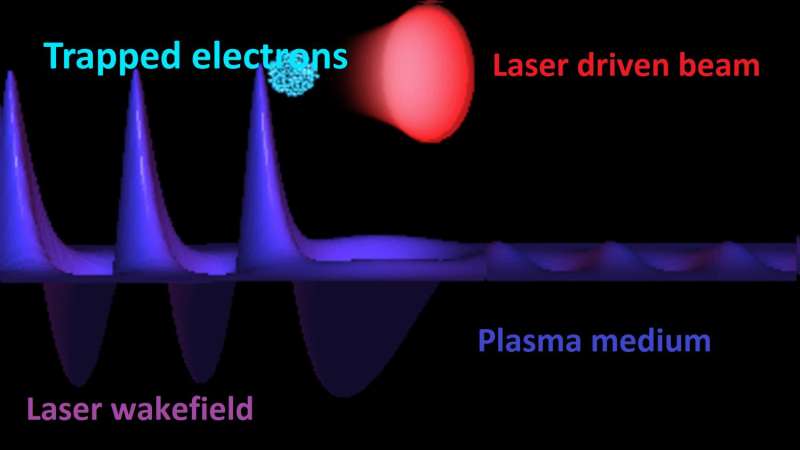Credit: The Cockcroft Institute, University of Liverpool
Accelerator scientists from across Europe are collaborating to design the world's first high energy plasma-based accelerator, which will be stronger and more compact than the current accelerators used by industry today, opening up the opportunity to use the beams for entirely new types of application. The consortium, called EuPRAXIA, brings together 16 institutions and 18 associated partners from more than eight countries, it has just had its kick-off meeting.
The accelerator would use extremely powerful lasers to generate a plasma, 'the fourth state of matter,' to propel electrons at the speed of light, and provide a high energy electron beam of industrial quality. Two user areas will be incorporated to investigate potential applications, for example in the generation of ultra-bright light, the development of new materials or non-destructive testing for aircraft or nuclear facilities.
Professor Carsten P. Welsch, Director of Communication at the Cockcroft Institute is a member of the project's Management Team. He explains that EuPRAXIA is an important intermediate step between proof-of-principle experiments and ground-breaking, ultra-compact accelerators for science, industry, medicine or the energy frontier.
"The goal of this ambitious project is to produce a conceptual design report for the world's first 5GeV plasma-based accelerator. This includes for example beam dynamics studies that help better understand beam-plasma matching, as well as the development of innovative diagnostics to fully characterise all aspects of the plasma and the beam.
"Although there has been academic research into plasma-based high gradient accelerators, no infrastructure exists where the quality of the accelerated beam satisfies the requirements of industry. Creating such a facility would be a major breakthrough and would attract users from many different sectors.
"Assuming results from the final accelerated beam would be even better than that currently achieved, for example ultra-short high energy electron pulses generating highest quality light pulses, then many additional applications across material and life sciences, chemistry and surface studies come into reach."
In physics, plasma is an electrically conducting medium with positively and negatively charged particles. It is referred to as the fourth state of matter after solid, liquid and gas and can be created from a gas by applying high energy. Nearly all visible matter in the universe is in a plasma state (for example the sun is a plasma star.)
EuPRAXIA will direct a laser through a plasma medium, creating a wave and forcing the electrons within the plasma to create a strong electric field. Oscillating between the transverse field of an electromagnetic wave and the longitudinal field of a plasma wave accelerates the electrons, creating a high quality beam.
Plasma is the most effective known transformer of an electromagnetic wave, and plasma accelerators can sustain an electric field up to 10,000 times greater than more conventional radiofrequency (RF) accelerators in a much shorter distance.
There is significant interest in reducing the size and costs of current accelerators to make them more accessible to industry.
One potential application is for non-destructive testing (NDT). By applying high-resolution radiography to a dense object, it would be possible to inspect the object without destroying its material capacities and strength. NDT within the aircraft industry can show defects or changes in thickness of the structure, providing early warning of corrosion and erosion. A compact, higher energy accelerator would be very desirable for NDT applications and allow new types of testing.
Another application is the production of free electron lasers (FELs), these are laser-like flashes of radiation, which can be used, for example, to decipher biomolecule structures and explore nanoparticles.
Dr. Ralph Assmann of DESY is the scientific coordinator of EuPRAXIA, he says: "Free electron lasers are powerful tools for fundamental and applied research, particularly for applications that benefit from bright pulses of light in specific wavelengths or that require the detection of ultra-fast phenomena such as the uncurling of proteins or movement of atoms. The potential is very exciting."
Plasma accelerator technology is still in the proof-of-principle phase, and several feasibility and practicality issues must be considered before it can be fully operational in industry.
However Professor Welsch is hopeful that perfecting plasma accelerators will drive a significant increase in industrial applications that require high quality beams. He stresses: "An important aspect of EuPRAXIA is to identify the exact user, experiment and application needs and determine where a plasma accelerator provides major benefits.
"EuPRAXIA aims to pave the way for a fundamentally new research infrastructure."
A parallel goal for EuPRAXIA is to identify the wider technological and human resource needs. Professor Welsch says that there is an urgent desire for more people who have been trained at the interface between laser technology and accelerator science. He says: "EuPRAXIA will create new research areas and our goal is to train more early career researchers in these areas and establish international training programs that will build up the necessary skill base."
More information: See presentation: https://www.cockcroft.ac.uk/plasma-acceleration-technology
Provided by The Cockcroft Institute, University of Liverpool






















